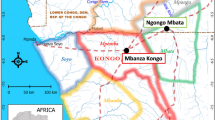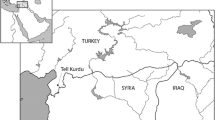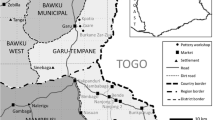Abstract
The study presents the results of neutron activation analysis (NAA) of contemporary pottery from Tigray Regional State, northern highland Ethiopia. This is the first regional-scale study of ceramic composition of Tigray’s pottery and is part of an ethnoarchaeological study of the material and social contexts of pottery production and consumption in Tigray’s Eastern (Misraqawi), Central (Mehakelegnaw), and North-western (Semien Mi’irabawi) zones. The analysis identifies clear compositional groups with strong regional patterns, an encouraging result for the use of NAA to study Tigray’s ancient pottery trade. Significantly, the study further contributes to discussions of how mutually constituted social identities of potters and consumers affect compositional patterning in the distribution of pottery in market networks.
Résumé
L’étude présente les résultats de neutron activation analysis (NAA) de la poterie contemporaine de l’État régional de Tigray, dans les hautes terres du nord de l’Éthiopie. Ceci est la première étude régionale de la composition céramique de la poterie du Tigray et fait partie d’une étude ethnoarchéologique des contextes matériels et sociaux de la production et de la consommation de poteries dans le Tigray oriental (Misraqawi), central (Mehakelegnaw) et nord-ouest (Semien Mi ‘irabawi) zones. L’analyze identifie des groupes de composition clairs avec des modèles régionaux forts, un résultat encourageant pour l’utilization du NAA pour étudier le commerce de la poterie ancienne de Tigray. De manière significative, l’étude contribue également aux discussions sur la façon dont les identités sociales mutuellement constituées des potiers et des consommateurs affectent la structuration de la composition de la poterie dans les réseaux de marché.















Similar content being viewed by others
References
Abbate, E., Bruni, P., & Sagri, M. (2015). Geology of Ethiopia: A review and geomorphological perspectives. In P. Billi (Ed.), Landscapes and landforms of Ethiopia, world geomorphological landscapes (pp. 33–64). New York: Springer.
Al Kital, R. A., Chan, L.-H., & Sayre, E. V. (1969). Neutron activation analysis of pottery sherds from Hajar bin Humeid and related areas. In G. W. Van Beek & H. B. Humeid (Eds.), Investigations at a pre-Islamic site in South Arabia (pp. 387–398). Publications of the American Foundation for the Study of Man, 5). Baltimore: Johns Hopkins Press.
Arnold, D. (2000). Does the standardization of ceramic paste really mean specialization? Journal of Archaeological Method and Theory, 7(4), 333–375.
Arthur, J. W. (2006). Living with pottery: Ceramic ethnoarchaeology among the Gamo of southwestern Ethiopia. Salt Lake City: University of Utah Press.
Arthur, J. W. (2014). Pottery uniformity in a stratified society: An ethnoarchaeological perspective from the Gamo of southwest Ethiopia. Journal of Anthropological Archaeology, 35, 106–116.
Avigad, D., Stern, R. J., Beyth, M., Miller, N., & McWilliams, M. O. (2007). Detrital zircon U-Pb geochronology of cryogenian diamictities and Lower Paleozoic sandstone in Ethiopia (Tigrai): Age constraints on neoproterozoic glaciation and crustal evolution of the southern Arabian-Nubian shield. Precambrian Research, 154, 88–106.
Beyth, M. (1972). To the geology of Central-western Tigre. Doctoral dissertation, Rheinischen Friedrich-Wilhelms-Universitat, Bonn.
Boulanger, M., & Glascock, M. D. (2012). Ethnoarchaeological study of ceramic production in Eastern Tigray, Ethiopia. Third report on chemical characterizations of pottery, clay and temper. Unpublished report. Archaeometry Laboratory, University of Missouri Research Reactor.
Boulanger, M., & Glascock, M. D. (2013). Ethnoarchaeological study of ceramic production in Eastern Tigray, Ethiopia. Fourth report on chemical characterizations of pottery, clay and temper. Unpublished report. Archaeometry Laboratory, University of Missouri Research Reactor.
Crummey, D. (2000). Land and society in the Christian kingdom of Ethiopia. Urbana: University of Illinois Press.
Curtis, M. C. (2008). New perspectives for examining change and complexity in the northern Horn of Africa during the first millennium BCE. In P. R. Schmidt, M. C. Curtis, & Z. Teka (Eds.), The archaeology of ancient Eritrea (pp. 329–348). Trenton: Red Sea Press.
D'Andrea, A. C., Manzo, A., Harrower, M. J., & Hawkins, A. L. (2008). The pre-Aksumite and Aksumite settlement of NE Tigrai, Ethiopia. Journal of Field Archaeology, 33, 151–176.
David, N. (Ed.). (2012). Metals in Mandara Mountains society and culture. Trenton: Africa World Press.
de Roux, H. (1976a). Aperçu sur la fabrication de la poterie à Yéha (Tigré). Annale D’Éthiopie, 10, 305–316.
de Roux, H. (1976b). Note sur des tessons céramiques de Degum (Tigré). Annale D’Éthiopie, 10, 71–80.
Dietler, M., & Herbich, I. (1994). Ceramics and ethnic identity: Ethnoarchaeological observations on the distribution of pottery styles and the relationship between the social contexts of production and consumption. In D. Binder & F. Audouze (Eds.), Terre cuite et société: La céramique, document technique, économique, culturel. XIVe Recontre Internationale d'archéologie et d'histoire d'Antibes (pp. 459–472). Juan-les-Pins: Editions APDCA.
Dietler, M., & Herbich, I. (1998). Habitus, techniques, style: An integrated approach to the social understanding of material culture and boundaries. In M. Stark (Ed.), The archaeology of social boundaries (pp. 232–263). Washington: Smithsonian Institution Press.
Dilley, R. M. (2000). The question of caste in West Africa with special reference to Tukulor craftsmen. Anthropos, 95, 149–165.
Dilley, R. M. (2010). Reflections on knowledge practices and problems of ignorance. Journal of the Royal Anthropological Institute (N.S.), S176–S192.
Ferrari, G., Ciampalini, R., Billi, P., & Migon, P. (2015). Geomorphology of the archaeological area of Axum. In P. Billi (Ed.), Landscapes and landforms of Ethiopia, world geomorphological landscapes (pp. 147–161). New York: Springer.
Frank, B. (1998). Mande potters and leatherworkers. Washington: Smithsonian Institution Press.
Freeman, D., & Pankhurst, A. (Eds.). (2003). Peripheral people: The excluded minorities of Ethiopia. Lawrenceville: Red Sea Press.
Gautier, J. (1976). Étude de poteries provenant d’Éthiopie (périods pré-Axoumite et Axoumite) effectuée par le laboratoire de Recherche des Musées de France, avec introduction par H. de Roux. Annales D’Éthiopie, 10, 57–70.
Geological Survey of Ethiopia, & Kazmin, V. (United Nations). (1973). Geological map of Ethiopia, map, 1:2,000,000. Addis Ababa: Geological Survey of Ethiopia.
Getaneh, W. (2002). Geochemistry provenance and depositional tectonic settling of the Adigrat sandstone, northern Ethiopia. Journal of African Earth Sciences, 35, 185–198.
Gijanto, L. (2011). Exchange, interaction, and change in local ceramic production in the Niumi commercial center on the Gambia River. Journal of Social Archaeology, 11(1), 21–48.
Glascock, M. D. (1992). Characterization of archaeological ceramics at MURR by neutron activation analysis and multivariate statistics. In H. Neff (Ed.), Chemical characterization of ceramic pastes in archaeology (pp. 11–26). Madison: Prehistory Press.
Gokee, C. D. (2011). Practical knowledge and politics of encounter along the lower Falémé River, Senegambia (c. AD 1500-1925). Azania: Archaeological Research in Africa, 46(3), 269–293.
Gosselain, O. (1994). Skimming through the potters' agendas; an ethnoarchaeological study of clay selection strategies in Cameroon. MASCA Research Papers in Science and Archaeology, 11, 99–107.
Gosselain, O. (2001). Globalizing local pottery studies. In S. Beyries & P. Pétrequin (Eds.), Ethno-archaeology and its transfers, BAR International Series 983 (pp. 95–112). Oxford: Archaeopress.
Gosselain, O. (2008a). Mother Bella was not a bella. In M. T. Stark, B. J. Bowser, & L. Horne (Eds.), Cultural transmission and material culture breaking down boundaries (pp. 150–177). Tucson: University of Arizona Press.
Gosselain, O. (2008b). Thoughts and adjustments in the potter’s backyard. In I. Berg (Ed.), Breaking the mould: Challenging the past through pottery, BAR International Series 1861 (pp. 67–79). Oxford: Archaeopress.
Gosselain, O. (2016). The world is like a beanstalk: Historicizing potting practice and social relations in the Niger River area. In A. P. Roddick & A. B. Stahl (Eds.), Knowledge in motion: Constellations of learning across time and place (pp. 36–66). Tucson: University of Arizona Press.
Gosselain, O., & Livingstone Smith, A. (2005). The source. Clay selection and processing practices in sub-Saharan Africa. In A. Livingstone Smith, D. Bosquet, & R. Martineau (Eds.), Pottery manufacturing processes: Reconstruction and interpretation (pp. 33–47). Oxford: Archaeopress.
Haaland, G., & Haaland, R. (2007). God of war, worldly ruler, and craft specialists in the Meroitic Kingdom of Sudan: Inferring social identity from material remains. Journal of Social Archaeology, 7(3), 372–392.
Harlow, D. (2011). Investigation of aspects of the raw materials used in ceramic production in Eastern Tigray. Master's thesis, University of Calgary.
Kohtamaki, M. (2010). An ethnoarchaeological study of Twa potters in southern Rwanda. Azania, 45(3), 298–320.
Lave, J., & Wenger, E. (1991). Situated learning: Legitimate peripheral participation. Cambridge: Cambridge University Press.
LaViolette, A. (2000). Ethno-archaeology in Jenne, Mali. BAR International Series 838. Oxford: Archaeopress.
Livingstone Smith, A. (2000). Processing clay for pottery in northern Cameroon: Social and technical requirements. Archaeometry, 42(1), 21–42.
Livingstone Smith, A., & Van der Veken, A. (2007-2009). The "Crossing Borders Project": Pottery traditions in Katanga (DRC). Afrique: Archéologie & Arts, 5, 141–148.
Lunde, P., & Porter, A. (Eds) (2004). Trade and travel in the Red Sea region: Proceedings of the Red Sea Project 1 held at the British Museum October 2002. BAR International Series 1269. Oxford: Archaeopress.
Lyons, D. (2007). Cuisine and identity: An ethnoarchaeological example from eastern Tigray, Ethiopia. Journal of Social Archaeology, 7(3), 346–371.
Lyons, D. (2014). Perceptions of consumption: Constituting potters, farmers and blacksmiths in the culinary continuum in Eastern Tigray, northern highland Ethiopia. African Archaeological Review, 31(2), 169–201.
Lyons, D., & Freeman, A. (2009). “I’m not evil”: Materialising identities of marginalised potters in Tigray region, Ethiopia. Azania, 44(1), 75–93.
Mahias, M.-C. (1993). Pottery techniques in India. In P. Lemonnier (Ed.), Technological choices: Transformation in material cultures since the Neolithic (pp. 157–180). London: Routledge.
Mayor, A. (2010). Ceramic traditions and ethnicity in the Niger Bend, West Africa. Journal of Ethnoarchaeology, 2(1), 5–48.
Michels, J.W. (2005). Changing settlement patterns in the Aksum-Yeha region of Ethiopia: 700 BC-AD 850. BAR International Series 1446. Oxford: Archaeopress.
Natali, C., Beccaluva, L., Bianchini, G., & Siena, F. (2013). The Axum-Adwa basalt-trachyte complex: A late magmatic activity at the periphery of the Afar plume. Contributions to Mineralogy and Petrology, 166, 351–370.
Neff, H. (2000). Neutron activation analysis for provenance determination in archaeology. In E. Ciliberto & G. Spoto (Eds.), Modern analytical methods in art and archaeology (pp. 81–134). New York: Wiley.
Nicklin, K. (1979). The location of pottery manufacture. Man, New Series, 14, 435–458.
Pankhurst, R. (1990). A social history of Ethiopia. Addis Ababa: Institute of Ethiopian Studies, Addis Ababa University.
Phillipson, D. (2012). Foundations of an African civilisation: Aksum & the northern Horn 1000 BC – AD 1300. Rochester: James Currey.
Porter, A. (2004). Amphora trade between South Arabia and East Africa in the first millennium BC: A re-examination of the evidence. Proceedings of the Seminar for Arabian Studies, 34, 261–275.
Quirin, J. (2010). The evolution of the Ethiopian Jews A history of the Beta Israel (Falasha) to 1920. Hollywood, CA: Tsehai Publishers.
Rice, P. M. (1981). Evolution of specialized pottery production: A trial model. Current Anthropology, 22, 219–240.
Rice, P. M. (1987). Pottery analysis. A sourcebook. Chicago: University of Chicago Press.
Robion-Brunner, C. (2010). Forgerons et sidérurgie en pays dogon. Journal of African Archaeology Monograph Series vol. 3. Frankfurt: Africa Magna Verlag.
Roddick, A. P., & Stahl, A. B. (2016). Knowledge in motion: Constellations of learning across time and place. Tucson: University of Arizona Press.
Salamon, H. (1999). The hyena people. Ethiopian Jews in Christian Ethiopia. Berkeley: University of California Press.
Sernicola, L., & Phillipson, L. (2011). Aksum’s regional trade: New evidence from archaeological survey. Azania: Archaeological Research in Africa, 46(2), 190–204.
Sillar, B. (1997). Reputable pots and disreputable potters: Individual and community choices in present-day pottery production and exchanges in the Andes. In C. C. Cumberpatch & P. Blinkhorn (Eds.), Not so much a pot, more a way of life (pp. 1–20). Oxford: Oxbow Books.
Smith, M. L. (2013). Caste as a cooperative economic entitlement strategy in complex societies of the Indian subcontinent and sub-Saharan Africa. In D. M. Carballo (Ed.), Cooperation and collective action: Archaeological perspectives (pp. 275–297). Boulder: University Press of Colorado.
Stahl, A. B. (2016). Crafting life in turbulent times communities of practice in the western Volta Basin from the 13th to the 17th century A.D. In A. P. Roddick & A. B. Stahl (Eds.), Knowledge in motion: Constellations of learning across time and place (pp. 179–215). Tucson: University of Arizona Press.
Stahl, A. B., Cruz, M. D., Neff, H., Glascock, M. D., Speakman, R. J., Giles, B., & Smith, L. (2008). Ceramic production, consumption and exchange in the Banda area, Ghana: Insights from compositional analyses. Journal of Anthropological Archaeology, 27, 363–381.
Sterner, J., & David, N. (1991). Gender and caste in the Mandara highlands: Northeastern Nigeria and northern Cameroon. Ethnology, 30, 355–369.
Sterner, J., & David, N. (2003). Action on matter: The history of the uniquely African tamper and concave anvil pot-forming technique. Journal of African Archaeology, 1(1), 3–34.
Tamari, T. (1991). The development of caste systems in West Africa. The Journal of African History, 32(2), 221–250.
Tamari, T. (2005). Kingship and caste in Africa: History, diffusion and evolution. In D. Quigley (Ed.), The character of kingship (pp. 141–169). Oxford: Berg.
Tesfamichael, G., De Smedt, F., Miruts, H., Solomon, G., Kassa, A., Kurkura, K., et al. (2010). Large-scale geological mapping of the Geba basin, northern Ethiopia. Tigray Livelihood Paper no. 9, VLIR – Mekelle University IUC Program.
Tomber, R. (2005). Aksumite and other imported ceramics from early historic Kamrej. Journal of Indian Ocean Archaeology, 2, 99–102.
Van Beek, W. (1982). “Eating like a blacksmith”: Symbols in Kapsiki ethno-zoology. In P. E. de Josselin de Jong & E. Schwimmer (Eds.), Symbolic anthropology in the Netherlands (pp. 114–124). Den Haag: Verhandelingen van het Koninklijk Institutuut voor Taal-, Land- en Volkenkunde 95.
Vander Linden, M. M. (2001). Social dynamics and pottery distribution in the Faro department, northern Cameroon. African Archaeological Review, 18(3), 135–151.
Wade, J. H. (2012). The wife of the village: Understanding caste in the Mandara Mountains. In N. David (Ed.), Metals in Mandara Mountains society and culture (pp. 257–284). Trenton: Africa World Press.
Wayessa, B. (2016). Toward a history of the Oromo of Wallaga in southwestern Ethiopia: An ethnoarchaeological study of ceramic technological style and tuber crop domestication. PhD Dissertation, University of Calgary.
Weiss, C., Köster, M., & Japp, S. (2016). Preliminary characterization of pottery by Cathodoluminescence and SEM-EDX analyses: An example from the Yeha region (Ethiopia). Archaeometry, 58(2), 239–254.
Wenger, E. (1998). Communities of practice: Learning, meaning, and identity. New York: Cambridge University Press.
Wolf, P., & Nowotnick, U. (2010). The Almaqah temple of Meqaber Ga'ewa near Wuqro (Tigray, Ethiopia). Proceedings of the Seminar for Arabian Studies, 40, 367–380.
Zazzaro, C., Cocca, E., & Manzo, A. (2014). Towards a chronology of the Eritrean Red Sea port of Adulis (1st-early 7th century AD). Journal of African Archaeology, 12(1), 43–73.
Acknowledgements
This project is indebted to the generosity of potters, farmers, merchants, and village administrators of Selekeleka, Akatsl, Ebalay, Dershan, Yeha, Gendebta, Adinfas, Adi Keshi, Adwa, Adi Ayfela, Adi Geba, Angohl, Aba Makreita, Daga, Hadush Adi, and Adi Mariam who participated in our study and contributed to our knowledge of pottery production and consumption in Tigray. Funding for this project was provided by Wenner-Gren Foundation Post-Doctoral Research Grants 7934, 8449, 8956; National Geographic Society Committee for Research and Exploration Grant #9065-12; a University of Calgary Research Grant, a Killam Foundation Enhancement Grant; the Social Science and Humanities Research Council (Joseph-Armand Bombardier Canada Graduate Scholarship MA Scholarship 766-2010-0317); University of South Carolina and the Walker Institute. We gratefully acknowledge the generous support and permission to conduct this research that was provided by the Ethiopian Authority for Research and Conservation of Cultural Heritage (ARCCH) in Addis Ababa; the National Regional State of Tigrai Tourism Bureau in Mekelle; the Geological Survey of Ethiopia in Addis Ababa; and Woreda offices in Tahtai Maichow, Wukro Maray, Mezaba Zana, Shire, Adwa, Sinkata, and Tabia chairs for Mai Maghelta, Hadush Adi, Marium Agamat, Ra Ilhe, Yeha, Gendebta, Selekeleka, Hafken, and Lemate. Special thanks to Michael Sowbeka, Temesgen Tadese, Tedros Girmay, Mulubrhan G/Sellassie, Degol Fissahaye, Daniel G/Kidane, Goitum Fitsom, Atakilte G/Tsedik, Zelealem Tesfay G/Tsedik, and ARCCH field inspectors Gezahegne Girma and Degene Dandena Gulti. We thank Dr. Temesgen Burka (Addis Ababa U.), Dr. Andrea Freeman (U. Calgary), Dr. Bula Wayessa (SUNY New Paltz), Getachew Nigus (U. Calgary), and Diane Caird (XRD Lab, U. Alberta). Dr. Michael Glascock (MURR) and his team provided advice that was critical to the success of this project. We thank Dr. Matthew Boulanger for his comments and Fig. 15, and Kees de Ridder for the French abstract. The authors appreciate and thank the anonymous reviewers whose comments contributed to this paper.
Funding
Diane Lyons received research grants from the Wenner-Gren Foundation Post-Doctoral Research Grants (7934, 8449, 8956), the National Geographic Society Committee for Research and Exploration Grant 9065-12, The University of Calgary Research Grant, and a Killam Foundation Enhancement Grant.
Diana Harlow’s research was funded by the Social Science and Humanities Research Council (Joseph-Armand Bombardier Canada Graduate Scholarship MA Scholarship 766-2010-0317).
Joanna Casey was funded by grants from the University of South Carolina and the Walker Institute.
Author information
Authors and Affiliations
Corresponding author
Ethics declarations
This research was conducted under ethics certificates issued by the Conjoint Faculties Research Ethics Board of the University of Calgary. Information was obtained with the informed and voluntary consent of all participants in the project. Permits to conduct research were obtained from the Ethiopian Authority for Research and Conservation of Cultural Heritage (ARCCH) in Addis Ababa, the National Regional State of Tigrai Tourism Bureau in Mekelle, the Geological Survey of Ethiopia in Addis Ababa, and Woreda offices in Tahtai Maichow, Wukro Maray, Mezaba Zana, Enda Selassie (Shire), Adwa, Sinkata, and Tabia chairs for Mai Maghelta, Hadush Adi, Marium Agamat, Ra Ilhe, Yeha, Gendebta, Selekeleka, Hafken, and Lemate.
Conflict of Interest
The authors declare that they have no conflict of interest.
Rights and permissions
About this article
Cite this article
Lyons, D., Ferguson, J., Harlow, D. et al. Marginalized Potters and Ceramic Compositional Groups: Neutron Activation Analysis of Contemporary Pottery from Tigray, Northern Highland Ethiopia. Afr Archaeol Rev 35, 567–595 (2018). https://doi.org/10.1007/s10437-018-9311-5
Published:
Issue Date:
DOI: https://doi.org/10.1007/s10437-018-9311-5




